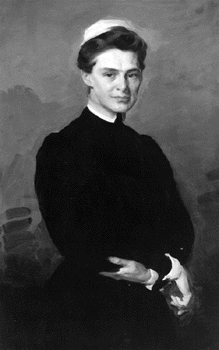|
|
Hopkins History: M. Adelaide Nutting Shaped Today's School of NursingBy Kate PipkinSchool of Nursing |

M. Adelaide Nutting once said, "If I had as much strength as spirit, there is nothing I would be afraid to undertake." As a member of the first graduating class of Johns Hopkins School of Nursing in 1891 and the school's second superintendent, Nutting knew a thing or two about the kind of strength and spirit it takes to be a Hopkins nurse.
 |
| In her 1906 portrait by Cecilia Beaux, M. Adelaide Nutting holds her red leather notebook. |
Now, almost 106 years after she was named superintendent, Nutting's name is still spoken throughout the halls of the School of Nursing, and her impact on the profession continues to be felt. Even in those early days, the School of Nursing enjoyed a reputation of excellence, but Nutting knew it could be even better. Although physically petite, Nutting still managed to be an imposing figure, striding through the hospital units (then referred to as wards) in her starched black superintendent's uniform, clutching the small red book she used for recording notes.
One of her first administrative moves was to petition Hopkins' board of trustees to make the nursing program three years instead of two. Nutting believed that additional time spent on clinical and classroom studies would strengthen the educational experience for nursing students and ultimately make them better nurses. The board of trustees, led by Dr. Henry Hurd, approved the expansion. Nutting's work, however, was far from over.
Her next challenge was to attempt to reduce the number of hours nursing students worked on the hospital wards. Toward the end of the 19th century, it was not unusual for nursing students to work between 60 and 100 hours a week. They were essentially cheap labor for hospitals. Nutting had the vision and courage to stand up and fight for decent conditions for nurses. She argued to the board of trustees that not only were such hours unhealthy for the students, but their time working on the wards greatly diminished the time and effort they could put into their education. In addition to her reform of nursing education, Nutting was an advocate of initiating academic scholarships for students.
An astute businesswoman ahead of her time, Nutting was aware of the importance of financial independence and wanted to see the School of Nursing standing on its own. The school was given an allowance of sorts from the hospital, but Nutting found such dependence distasteful. She called upon alumnae of the school to establish an endowment of $1 million. It didn't happen overnight, but when the School of Nursing was re-established in 1984 as a degree-granting division of the university, the Alumni Association presented the very first endowed chair, named for M. Adelaide Nutting.
In 1906, shortly before she left the School of Nursing, Nutting sat for her portrait by artist Cecilia Beaux. In the book The Johns Hopkins Hospital School of Nursing 1889-1949, by Ethel Johns and Blanche Pfefferkorn, Nutting describes the experience: "Then she asked if there were no papers or something that I was used to carrying in my hand and laughingly I mentioned the little red leather notebook, which she quickly decided to be the very thing needed especially after hearing that I seldom made rounds without it so that it was familiar to my pupils as any part of my uniform."
According to alumna, faculty member and nursing history buff Susan Appling '73, Hopkins' School of Nursing continues to honor and recognize the leadership of Adelaide Nutting.
"The kind of vision, skill and leadership Adelaide Nutting possessed is timeless," Appling says. "She wasn't afraid to stand up for the profession and for her patients. The courage and intelligence of Ms. Nutting can serve as a role model for nursing students everywhere, but especially here at the school and hospital she loved so much."
In a letter to her former superintendent at Hopkins, Nutting said, "This is the dearest old Hospital in the world and I offer up perpetual psalms of thanksgiving that I came here instead of elsewhere."
|
On Jan. 28 the Discovery Health Channel will air the first two episodes of its five-part series Nurses, shot entirely at the Johns Hopkins Medical Institutions. Through fast-paced camera work, the show will depict the daily routine of Hopkins nurses as they wage a battle against death and disease. Each episode focuses on the men and women within a specialty. "Pediatrics" will premiere Jan. 28 at 8 p.m., with "Critical Care" to air at 9 p.m. the same night. The final three episodes--"Battling for Babies," "Touch of Mercy," an episode about cancer care, and "Nursing the Mind"-- will be shown on Feb. 18 at 8, 9 and 10 p.m. To read about the filming, which took place over the summer, log on to http://www.jhu.edu/~gazette/2000/jul3100/31tvdoc.html.
|
| GO TO JANUARY 8, 2001 TABLE OF CONTENTS. |
| GO TO THE GAZETTE HOME PAGE. |